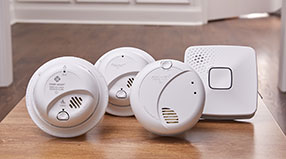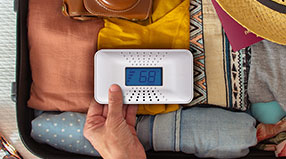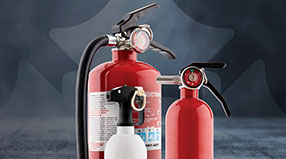Fire Extinguishers
Common Questions About First Alert Fire Extinguishers
What do I need to know about fire extinguishers?
First Alert Fire Extinguishers provide an immediate solution for quickly controlling and dispersing small fires that have the potential to grow and overwhelm. Available in a variety of sizes and class types, First Alert Fire Extinguishers can safely be installed in the home or commercial setting. When selecting a fire extinguisher for your home or business, it’s important to review the extinguisher’s rating. e.g. A fire extinguisher designed to put out electrical fires may not be suitable for handling flammable fires.
What are Fire Extinguisher Ratings?
All First Alert Fire Extinguishers feature a fire rating. These ratings are designed to reveal the types of fire that the fire extinguisher excels in putting out. This is important as fire types can vary e.g. flammable fires, combustible fires and electrical fires. First Alert Fire Extinguishers are available in the following three types:
-
Class A Fire Extinguishers are deigned to handle fires caused by ordinary combustibles. Some of the leading culprits that cause these fires would be combustible materials such as: firewood, cloth, plastic and paper. It is recommended that Class A Fire Extinguishers be setup near fireplaces and other areas that may pose a similar threat.
-
Class B Fire Extinguishers are used to combat fires caused by flammable liquids and combustible gas. These fires are capable of spreading extremely fast and can be attributed to gasoline, grease, oil and paints. Class B Fire Extinguishers should be installed where any of these are present e.g. garages, kitchens and sheds.
-
Class C Fire Extinguishers excel in putting out electrical fires. It should be noted that water cannot be used to extinguish an electrical fire. This will in fact result in exposing the surrounding area to electrocution. Electrical fires are commonly caused by electrical equipment, paneling, wiring and circuit breakers. Class C Fire Extinguishers should be placed in areas where electrical equipment/machinery is used and wherever electrical wiring is setup.
How do I use a fire extinguisher?
When using a First Alert Fire Extinguisher, you’re going to want to use the PASS Technique.
-
Pull the pin. Hold the fire extinguisher with the nozzle pointing away from you. You can then release the locking mechanism.
-
Aim low! Direct your aim at the base of the fire.
-
Squeeze the fire extinguisher's lever slowly and evenly.
-
Sweep the nozzle from side to side.
Where can I recharge my fire extinguisher?
Most fire extinguishers can be recharged, although they’ll require special equipment and parts to do so. While some extinguishers can be recharged, it can be dangerous without the right training. It’s recommended that a trained professional make sure your extinguisher is safe and gets recharged with the correct chemical extinguishing agent. Recharge should be done by a certified Fire Extinguisher Service Company local to you. The Fire Extinguisher Service company will perform inspection and/or maintenance as required, dependent on the age of the Fire Extinguisher.
Which fire extinguisher is right for me?
When searching for a residential/home fire extinguisher, it would be wise to consider one that covers multiple ratings. All First Alert Fire Extinguishers available online at the First Alert Store are multi-rated, meaning they can handle two or more types of fire. A First Alert Kitchen Fire Extinguisher offers dual protection via its Class B & Class C rating. For all around three class protection, there’s the First Alert Rechargeable Home Fire Extinguisher that can be used on Class A, B & C fires. It is recommended that fire extinguishers be installed on every level of the home. When used with First Alert Smoke and Fire Detectors, First Alert Fire Extinguishers are capable of adding significant fire protection to any home.



